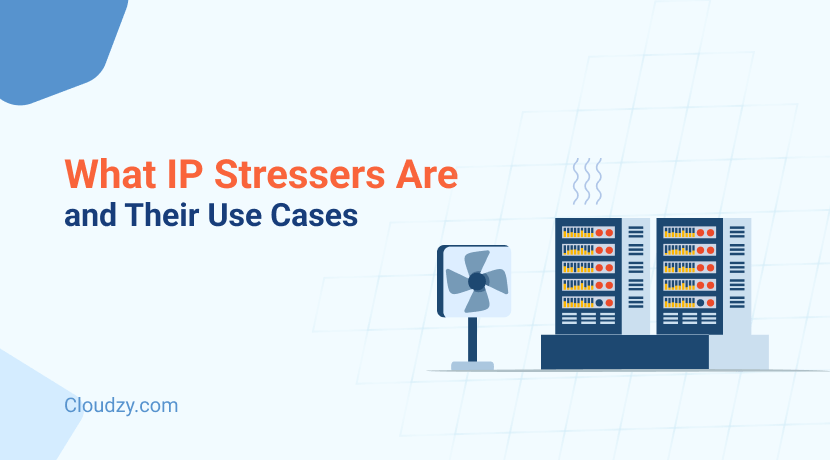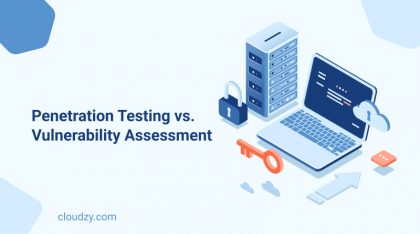How much does network reliability matter to you? Do you have any plans on how to tolerate high traffic volumes? Have you ever wondered how network administrators protect their systems against potential attacks? IP stressers provide an efficient solution to these questions. An IP stresser can show you how much workload your system is able to bear by simulating stress conditions. So, you can use it as an indicator of vulnerabilities and improve your system against disruptions. So far, you’ve learned about the very basic use case of an IP streeser and it certainly doesn’t look like a tool for evil activities. Unfortunately, IP stressers can also be used for malicious and illegitimate purposes. This blog post will delve into what an IP stresser is, how it works, and how to distinguish between its legitimate and illegitimate uses. We will also explore various IP stresser services, both paid and free. So stick along to learn about all these topics.
What Is an IP Stresser?
First and foremost, let’s explore what an IP stresser is and how it works. An IP stresser is one of the cybersecurity concepts like Penetration Testing with a different purpose and application. It is a tool that we use to test how strong and stable a network is. It basically simulates what happens when your network experiences heavy usage or is under attack.
How It Works
An IP stresser works by sending a massive amount of data packets to the target IP address. When these packets flood the network, it creates a stressful environment, similar to a real-world scenario where many users are trying to access the network at the same time. This scenario shows you how a network behaves under heavy pressure to attack. But how does an IP stresser generate this type of heavy traffic? And how does it force the traffic on your network? Here’s a simple breakdown of the process that will help you find the answer to these questions:
Traffic Generation
The IP stresser creates a large volume of traffic using various methods such as HTTP requests, UDP (User Datagram Protocol), or ICMP (Internet Control Message Protocol) packets. Since these protocols are common in regular network traffic, using them helps create a realistic stress test.
Traffic Sending
This generated traffic is then directed toward the target. The target is usually a server or a network device with an IP address. The goal is to mimic real-world traffic to see how well the network can handle it. The volume of the traffic an IP stresser sends depends on its power and the needs of the test.
Monitoring and Analysis
Network administrators monitor the performance of the network during the stress test. They look for slowdowns, failures, or any points where the network might crash. This helps them to find places where there’s room for improvement.
IP stressers are very important for making sure your network is capable of handling high pressure. They help network administrators find and fix weaknesses before real problems occur. So, you can consider an IP stresser as a preventive measure. In addition to IP Stressers, VAPT (Vulnerability Assessment and Penetration Testing) can be used as a proactive, preventive measure to enhance an organization’s overall security posture and organizations can stay ahead of evolving security threats, address vulnerabilities before they can be exploited, and implement robust preventive measures to enhance their overall cybersecurity posture.
Legitimate vs. Illegitimate Use of IP Stressers
IP stressers can be used for both good and bad purposes. Understanding the difference between legitimate and illegitimate use of IP stressers is important, especially for those working in network security.
Legitimate Use of IP Stressers
Improving network performance and security are the most important use cases of IP stressers. Here are some common legitimate uses:
Network Testing
The stimulated high traffic helps Network administrators test the strength and reliability of their networks. So, they can see how their network performs under pressure and identify any weak points that need fixing.
DDoS Resilience Testing
A Distributed Denial of Service (DDoS) attack is pretty much like what an IP stresser does. It floods a network with traffic to make it unavailable. The only difference is that it’s an actual attack. By using IP stressers, administrators can simulate DDoS attacks to see how well their defenses hold up. So, in times of a real DDoS attack, you are sure the network is strong enough to hold up.
Performance Optimization
Stressing the network also helps administrators gather some information about the network’s performance. They can later use this data to make adjustments and optimizations to the network.
Illegitimate Use of IP Stressers
Unfortunately, IP stressers can also be used for harmful purposes. These illegitimate uses are usually illegal and unethical. Let’s review what they are:
DDoS Attacks
Not only you can use IP stressors to simulate DDoS attacks, but you can also create real ones. After all, an IP stresser is able to generate massive traffic and send it to a specific IP address. So, attackers can use it to overwhelm the target with traffic, causing it to slow down or crash.
Cyber Vandalism
Malicious users might use IP stressers to target networks simply to cause chaos or damage. In other words, they are not targeted attackers with serious intentions, they’re just cyber vandalists who enjoy a little chaos. This form of cyber vandalism is done without any benefit other than to harm others.
Extortion
In some cases, attackers use IP stressers to threaten businesses with DDoS attacks unless they pay a ransom. So, they haven’t actually attacked yet. But they threaten to do so in exchange for some money. This is a form of cyber extortion and is highly illegal.
Using IP stressers for illegitimate purposes can have serious legal consequences. Laws around the world prohibit DDoS attacks and other malicious uses of network tools. If an attacker is proven to be engaged in such activities, they can face heavy fines and imprisonment.
What Is an IP Stresser as a Service?
The concept of an IPS dresser can be turned into a tool. An IP stresser as a service, also known as an IP booter or an IP address booter is a tool that is designed to test the strength of networks or servers. When offered as a service, these tools are hosted and managed by third-party providers, making it easier for users to access and use them without the need for specialized hardware or software.
IP stressers as a service offer various features, including:
- Scalability: This feature allows users to choose the intensity and duration of the stress tests based on their needs.
- User-Friendly Interfaces: These services typically come with easy-to-use dashboards that make configuration and launching tests simple.
- Comprehensive Reporting: They can provide detailed reports on the performance of the network that is under stress. These reports are helpful in pinpointing weaknesses.
Providers of IP Stressor Products (Paid Options)
Stresse.ru
Stresse.ru is a well-known IP stresser service that offers a range of features for both beginner and advanced users. One of its most important features is that although it has a paid version, you can use the basic plan for free ip booter with lifetime access. Here’s a list of its other features:
- High-Volume Traffic Simulation: It’s capable of generating large amounts of traffic to test the resilience of networks. So, it’s suitable for large networks that have a large capacity, and bringing them to their limits requires a large traffic volume.
- Customizable Attack Vectors: This feature allows users to tailor the type of traffic based on the specific characteristics of their network.
- 24/7 Support: Stresse.ru has great customer support to assist with any issues during stress testing.
SolarWinds
SolarWinds is a reputable name in network management and offers an IP stresser service that integrates seamlessly with its other network monitoring tools. Here’s a list of its key features:
- Integrated Network Monitoring: It provides real-time monitoring of network performance during stress tests. So, you can see how your network is performing in each stage of the testing.
- Detailed Analytics: It has comprehensive analytics and reporting tools to help identify bottlenecks and vulnerabilities. So, you can find every detail of your network’s performance in a single report.
- User-Friendly Interface: It also has an intuitive interface that makes it easy to set up and manage stress tests.
Nightmare Stresser
Nightmare Stresser is another popular choice for IP stress testing. It stands out for its:
- Wide Range of Attack Types: This IP stresser supports various stress test methods, including TCP, UDP, and HTTP-based attacks. So, you can choose the protocol of the invasive traffic based on your needs.
- High Capacity: This tool is capable of launching high-capacity attacks to test the limits of network infrastructure. So, it’s suitable for large and sophisticated networks.
- Flexible Pricing Plans: It offers different pricing plans to accommodate various budget needs.
Providers of IP Stressor Products (Free Options)
All of the three above-mentioned tools require you to buy a subscription. But there are also some IP stressers that are good quality options and don’t cause any fees although these services offer basic features compared to paid options they can be useful for simple testing scenarios. Let’s check them out:
Stresser.Zone
Stresser.Zone offers a basic but functional IP stresser service. It provides a user-friendly interface that’s simple and straightforward for easy test configuration. However, it’s only suitable for small to medium-scale tests.
Stressthem
Stressthem is another free option that responds to users who need straightforward stress testing capabilities. It provides fundamental stress testing features without any cost and it has a quick and easy setup process.
When choosing an internet stresser service, you should consider your specific needs, including the scale of testing, budget, and required features. While paid services like Stresse.ru, SolarWinds, and Nightmare Stresser offer comprehensive features and support, free IP stresser options can also be sufficient for basic testing. Understanding the capabilities and limitations of each option will help you make an informed decision for your network infrastructure.
Conclusion
In this blog, we explored how an IP stresser works and what its use cases are. If you want to have a functional network, you should familiarize yourself with all the possible preventive measures. Preventive security measures like vulnerability assessment, penetration testing, using IP stressers, etc. put you one step ahead of attackers.
Speaking of security, if you want to make sure your organization benefits from the most secure infrastructure, consider Cloudzy’s Cloud Server. Our cloud services come with powerful AMD EPYC™ processors, pre-installed Linux distribution of your choice, 24/7 support, and a 99.95% uptime guarantee. So, don’t hesitate to get yours with less than 5$.
FAQ
What does stressing the internet mean?
When we stress the Internet, we test its limits by simulating heavy traffic or load to evaluate performance, stability, and security. By doing this we can identify potential weaknesses and improve infrastructure.
How does an Internet booter work?
An Internet booter, or DDoS booter, is an online service that launches DDoS attacks. It pushes a server to its burnout limit with massive traffic from multiple sources.





